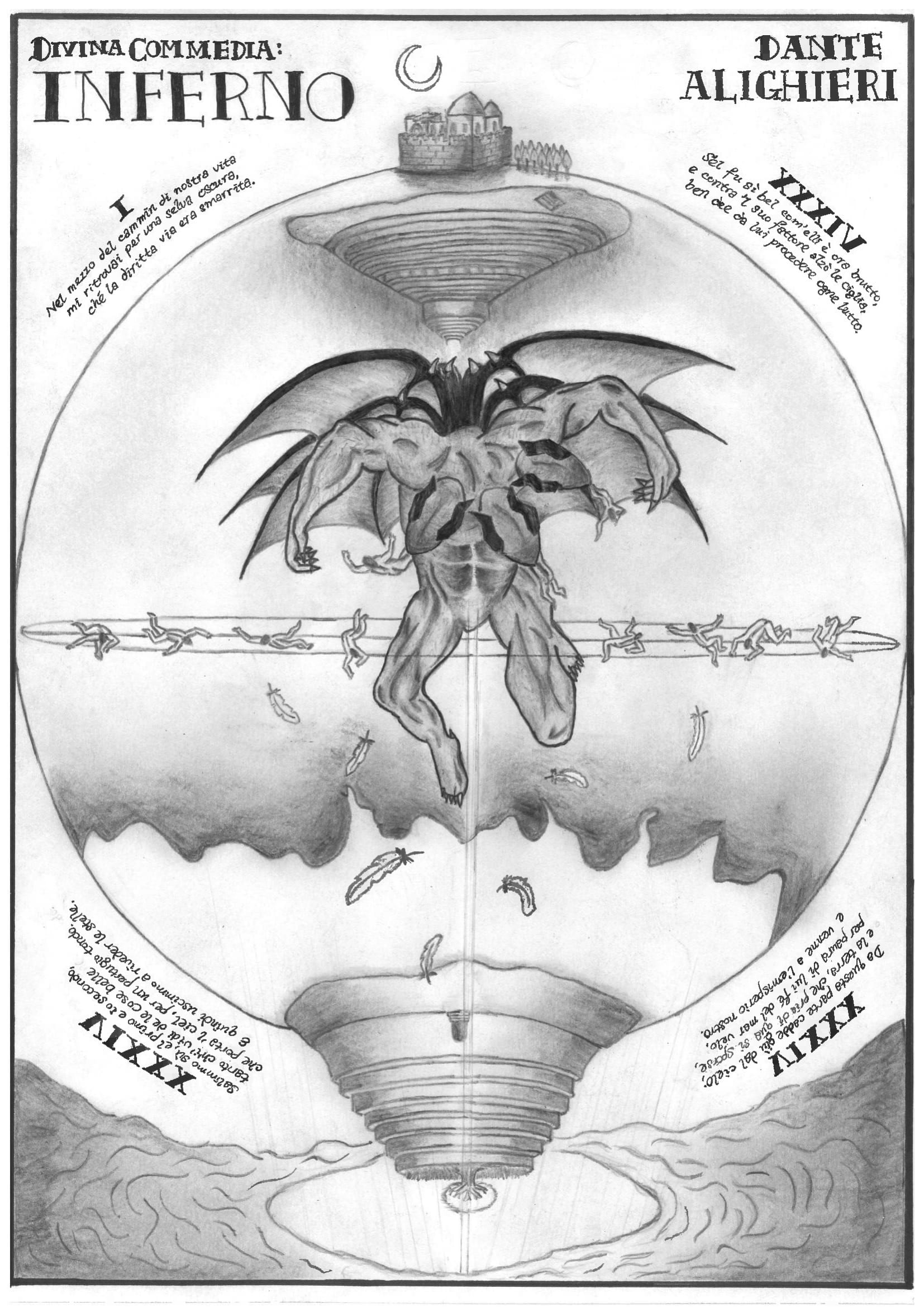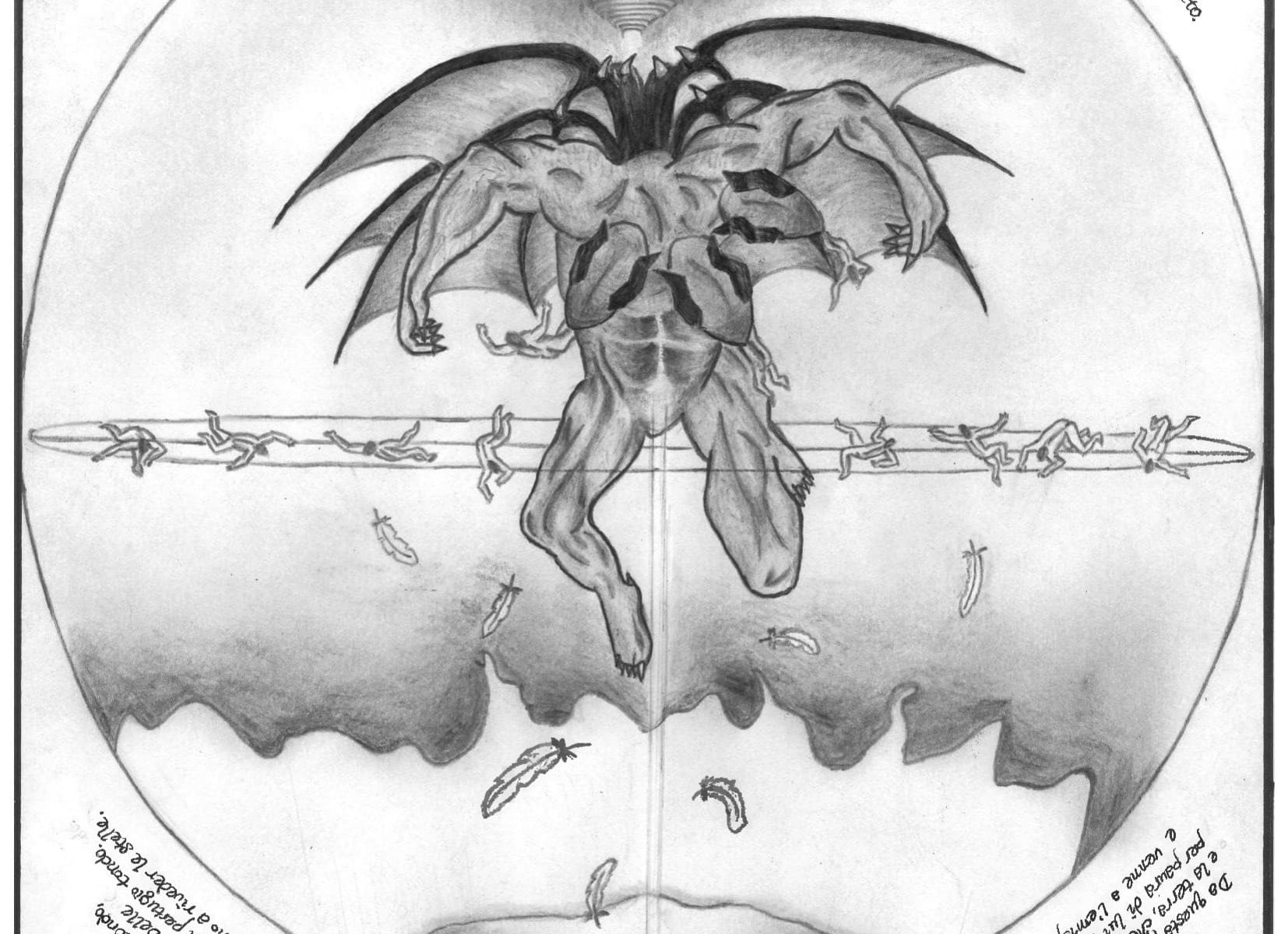CREATIVE PROJECT BY TOH HONG JIN (’23)
The Anatomy of Lucifer and the Universe
Visual Art (Drawing)
An Interpretation of Inferno
Death, Mourning and Memory in Medieval Literature (YHU3345)
2021


Artist’s Remarks
My creative interpretation for Dante’s Inferno is inspired primarily by Canto 34 (with elements of Canto 1 as well). Overall, I think what it illuminates about the text and Canto 34 especially is the general perspective of the world according to Dante’s theology, of how the journey through Inferno was possible in the first place (and why it was necessary), and it gives more insight into Lucifer, who was quite grossly diminished in the text.
The interpretation takes the form of a medieval manuscript page imitation, completed on paper entirely with pencil and ink, in black-and-white monochrome colour scheme. The imitation, done to pay homage to the Middle Ages and evoke its sense of history, is immediately visible with the black frame and labelling of the text’s title and author’s name in an olden-style typography. Choosing to imitate the artistry of a manuscript page also helps convey the grandeur befitting Dante’s tale, its genre, and its thematic / theological concerns. Meanwhile, the colour scheme is chosen to exude the solemn and serious mood of the text, and to play on the notion of “black and white” being indicative of good and evil, or morality in general. After all, morality (as determined by religion) is the core concern of the text. The monochrome scheme also makes the contrasts in shadings and gradients more visible, thereby allowing the art to seem more realistic.
The circle represents the boundaries of the mortal realm. Four quotes from Cantos 1 and 34 are written in accompaniment along the circle’s boundary, organised in clockwise direction, which forces the reader to flip the page upside down. This creates a dynamic in the page where two perspectives are possible, making the visual experience more interactive. The original Italian version of the quotes are chosen instead of the English version in order to remain faithful to the text’s origin and culture. For this very reason, the Cantos from which the quotes are picked are also indicated in Roman numerals instead of Arabic numerals. In addition, the use of Italian and Roman numerals points to Italy in general, the seat of the Catholic Church, and the Roman Empire, in doing so highlights their importance to Dante’s politics and his theology. The first quote comes from the opening of the text, the second from lines 34 to 36 (Canto 34) where the pilgrim exclaims the duality in Lucifer’s appearance (once beautiful but now ugly), the third from lines 121 to 124 (Canto 34) where Virgil explains the ingenious inversion of their perspective after passing Lucifer, and the fourth from the closing lines of the text where the duo climbed out of Hell and saw the skies once more.
At the top of the circle lies the moon, a human city, the dark wood which the pilgrim became lost in Canto 1, and the concentric landscape of Hell. These indicate where the pilgrim has come from in terms of both time and place. On the other side of the circle lies Purgatory, isolated from land (in accordance to then-contemporary belief that the southern hemisphere is covered in water, as mentioned by Virgil in Canto 34), and Heaven / Paradise, as hinted by the hole in the sky where light comes from (which also implies that the sun is somewhere there) and where the clouds appear gradually brighter.
The main subject, Lucifer, is enclosed within the circle. His size is exaggerated to a large scale to emphasise his being the heart of Hell and the pilgrim’s encounter with him as the climatic moment in Inferno. A second circle is drawn around his thighs to indicate the plane where he is trapped with sinners in wretched positions, as mentioned in Canto 34. Together, the circles and horizontal line separating the hemispheres puts Lucifer in a position as though he is being examined and his anatomy analysed for the reader of the manuscript page, an idea inspired by Da Vinci’s renowned Vitruvian Man drawing. Lucifer himself is depicted with a degree of artistic license. His possession of six wings is inferred from his being a former archangel; they now resemble (as indicated in Canto 34) those of a bat’s and they look like sails as well. If examined closer, there are thin hairs which are faintly visible all over his body (especially on his arms). His body’s hairy nature is downplayed to give more emphasis to the unnatural body posture and its bulging veins and muscles that seem almost painful. This is done to draw attention to his suffering (contrary to the image of him being a glorious ruler of Hell), as highlighted in Canto 34. The punishment of Lucifer is further enhanced with his heads lowered, as though he was weeping (noted by the pilgrim) and in shame. The lack of facial depiction also helps bring out the anticlimactic silence and lack of interaction in Canto 34, since without faces, no direct encounter is possible. The greatest human sinners as alleged by the pilgrim, are included, gnawed upon by Lucifer. The lack of visible mouths for Lucifer make the sinners appear almost like tongues, which evokes the imagery of the serpent, painting Lucifer as the greatest deceiver. The dark shading of Lucifer paints him as the embodiment of evil, yet the white space around him contrasts and brings out his paradoxical nature—that his existence serves to strengthen and reinforce the moral legitimacy and authority of the Christian God and His doctrines—aside from simply depicting the icy landscape of the deepest level of Hell.
When the manuscript is flipped upside down, the answer to Lucifer’s seemingly unnatural body posture is clearer. Paired with the superimposed drifting feathers, the motion of his fall from Heaven and grace is captured. This is something that I desired to flesh out the most from Canto 34, such that Lucifer appears to still be falling, and this motion is effectively immortalised. The feathers are those from his former archangel wings, drawn as such to indicate Lucifer’s past. The ray of light extended to Lucifer’s abdomen is the stairway to Purgatory and Heaven climbed by the pilgrim and Virgil. I chose to depict it as a ray of light so that the contrast between the darkness of Lucifer, Hell, and what was on the other side, could be made much starker and more evident. The sketchy pencil strokes that mark out the ladder conveys the uncertainty and fear about the journey that the pilgrim must undertake. The ray of light is drawn in a way such that the areas which it touches are somewhat whitened, and the sketchy pencil markings help to enhance its glow and allow it to shimmer, all to highlight the ethereal and strange nature of the pilgrim’s journey thus far from Hell, and beckons to what lies ahead.

